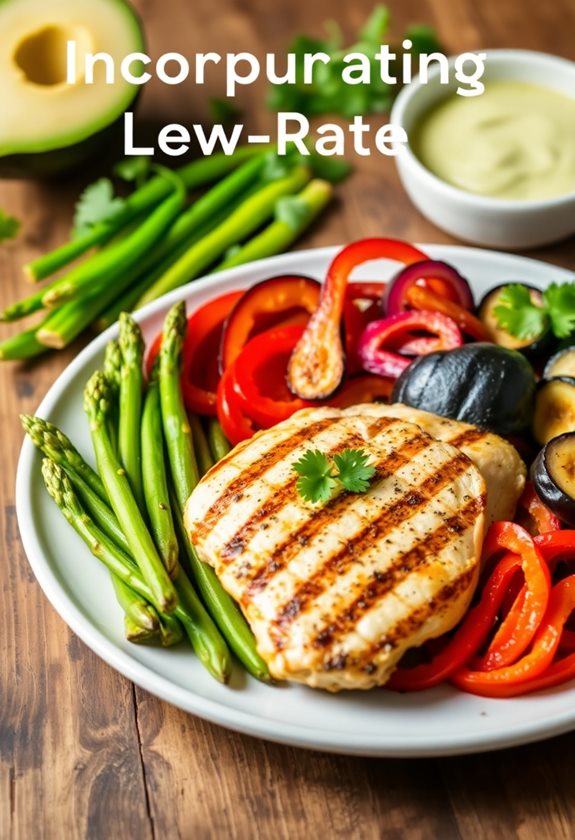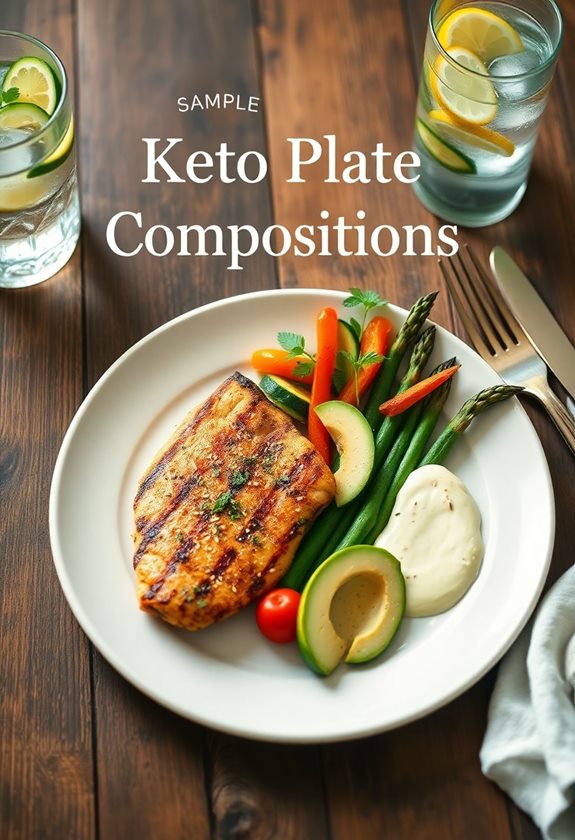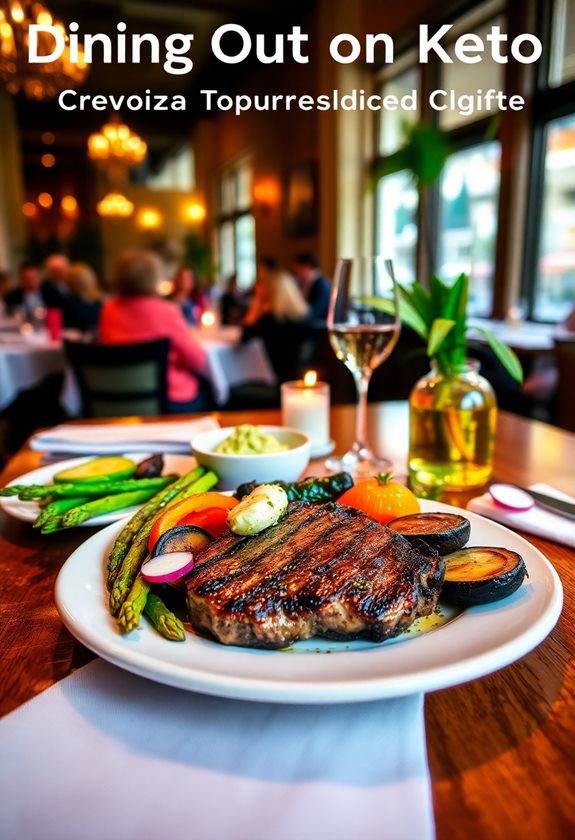Creating a balanced keto plate is simple! Start by filling half your plate with non-starchy veggies like spinach, zucchini, or broccoli. This boosts your nutrients while keeping carbs low. Next, fill one-fourth with protein, like grilled chicken or fatty fish. Finally, add healthy fats, like avocado or olive oil, to make up the last quarter. This way, you've got a tasty, balanced meal! 🙌 Don't forget to prep your meals ahead of time to stay on track. It's all about the right mix! You'll discover even more tips to make keto meal prep easy and enjoyable!
Key Takeaways
- Divide your plate into three sections: half for non-starchy vegetables, one-fourth for protein, and one-fourth for healthy fats.
- Choose quality protein sources like grass-fed beef, fatty fish, eggs, or low-carb dairy to meet keto requirements.
- Fill half your plate with low-carb vegetables such as spinach, zucchini, and broccoli for essential nutrients while keeping carbs low.
- Prioritize healthy fats, making up 75-80% of your calorie intake, using options like avocado oil, coconut oil, and nuts.
- Prepare and portion meals in advance to simplify adherence to keto guidelines and ensure balanced plates.
Understanding Keto Plate Basics

Creating a balanced keto plate boils down to understanding the right proportions of its components. Imagine your plate divided into three sections: half for non-starchy vegetables, one-fourth for protein, and one-fourth for healthy fats. This setup helps you hit the ideal macronutrient ratios in your meals. Incorporating nutrient-dense options such as MCT powders can also enhance your energy levels and support your ketogenic goals, as they serve as a rapid energy source when included in your meal plan. MCTs serve as a rapid energy source.
Why focus on non-starchy veggies? They're packed with essential micronutrients and help keep your carbs low. Think leafy greens, zucchini, or cauliflower. By filling half your plate with these, you're also staying within that daily carb limit of 20-50 grams.
Next, let's talk about healthy fats. You want to include things like avocado oil, olive oil, and grass-fed ghee. These fats should be a part of every meal, making sure you're reaching that 75-80% fat intake on a keto diet.
Choosing Quality Protein Sources
Choosing quality protein sources is essential for maintaining your ketogenic diet effectively. You want to focus on options that not only provide essential amino acids but also fit your high-fat diet. So, have you considered grass-fed beef? It's a fantastic choice, as are fatty fish like salmon and mackerel. They're rich in healthy fats and low in carbs, perfect for your low-carb diet. Additionally, consider including raw peeled shrimp as a versatile protein source; they are quick to prepare and can enhance your meals.
When picking meats, go for cuts that are higher in fat, like ribeye steak or pork belly. These align perfectly with keto's need for 70-80% fats. Don't overlook eggs, either! They're versatile and packed with nutrients, making them a great option for any meal.
You can also incorporate low-carb dairy products like full-fat cheese and Greek yogurt. They boost your protein intake while adding more healthy fats to your plate. Aim for about 1g of protein per kilogram of your body weight to keep your meals balanced.
Incorporating Low-Carb Vegetables

While you focus on protein and fats in your ketogenic diet, don't forget the importance of incorporating low-carb vegetables. These non-starchy vegetables should fill half your keto plate, offering essential nutrients without greatly raising your carbohydrate intake. Think about adding leafy greens like spinach or kale, along with zucchini, cauliflower, asparagus, and mushrooms. These choices help keep your net carb count low while making your meals more satisfying. Additionally, consider pairing these veggies with snacks like Fat Snax Keto Cookies for a delicious low-carb treat that complements your meal plan.
Have you considered how cooking your veggies in healthy fats like olive oil can elevate both flavor and nutrition? It's a win-win! This not only makes your dishes tastier, but it also boosts your overall fat intake, which is key for staying in ketosis. Remember, you should aim for a daily carbohydrate limit of 20-50 grams, mostly from these low-carb vegetables.
Prioritizing Healthy Fats
Healthy fats are the cornerstone of a successful ketogenic diet, making up about 75-80% of your total calorie intake. They're essential for keeping you in ketosis and feeling satisfied. Think about it: what's a keto plate without rich, flavorful fats?
Here's a simple way to visualize your healthy fats:
| Healthy Fats | Usage Ideas |
|---|---|
| Avocado Oil | Drizzle over veggies |
| Coconut Oil | Use for cooking protein |
| Grass-fed Ghee | Spread on low-carb bread |
Using tasty oils and fats, like avocado oil and coconut oil, not only boosts your fat consumption but also enhances the flavors in your meals. Ever tried topping your grilled chicken with some creamy avocado? Yum! This balanced approach helps you meet your macro goals without feeling deprived.
You can also add nut butter or MCT oil to smoothies for an extra kick of healthy fats. By dispersing fats throughout your plate, you'll enjoy a nutrient-dense meal that's enjoyable and easy to stick with. So, how do you plan to incorporate healthy fats into your next meal? 🌟
Sample Keto Plate Compositions

Creating a balanced keto plate is all about achieving the right macronutrient ratios to keep you in ketosis and feeling satisfied. So, what does that look like? Imagine this: half of your plate filled with colorful non-starchy vegetables like broccoli, asparagus, or cauliflower. These not only keep your carb counts low but also pack in essential vitamins and minerals.
Now, for the other half, divide it into two parts. One-fourth should be a source of protein, like grilled chicken or salmon. They help you stay full and support muscle health. The last quarter is where the magic happens—healthy fats! Think avocado, nuts, or olive oil. These add flavor and are vital for maintaining ketosis.
Some keto meal ideas could be sautéed spinach and mushrooms in olive oil with grilled chicken, or roasted zucchini and bell peppers served with salmon drizzled in avocado oil. By sticking to this meal composition, you can enjoy tasty dishes while achieving the right macronutrient ratios. Isn't it great to know that delicious meals can help you stay on track? 🍽️
Tips for Meal Prep
Meal prep can be a game-changer for your keto journey, making it easier to stick to your dietary goals. By planning ahead, you can guarantee your meals are packed with high-fat, low-carb ingredients that meet your macronutrient ratios. Here are three tips to help you get started:
- Batch Cook Protein: Cook chicken, beef, or fish in bulk and store them in portion containers. This makes meal assembly a breeze during the week.
- Prep Non-Starchy Veggies: Chop zucchini, cauliflower, and leafy greens in advance. Store them in airtight containers for quick access when you need to whip up a meal.
- Use Healthy Fats: Prepare dressings or marinades using olive oil or avocado oil. These not only enhance flavor but also boost your healthy fat intake.
Investing in meal prep tools like a food scale and portion containers can help you measure ingredients accurately. Isn't it nice to make your keto life simpler? With these tips, you'll be on your way to enjoying delicious, balanced meals while sticking to your keto lifestyle! ✨
Dining Out on Keto

Dining out on a keto diet can often feel challenging, but with a bit of strategy, you can enjoy delicious meals without straying from your goals. Have you ever scanned a menu and felt overwhelmed? Start by looking for grilled, baked, or sautéed options. These tend to be lower in carbs compared to fried or breaded dishes.
Don't hesitate to ask for modifications! You can swap out starchy sides for extra non-starchy vegetables or request sauces on the side to keep your hidden carb intake in check. Familiarizing yourself with the menu beforehand helps you spot keto-friendly meals, making it easier to avoid those tempting high-carb choices.
Watch out for sauces and dressings; they often hide sugars. Instead, go for healthy alternatives like olive oil, vinegar, or lemon. Many restaurants are happy to accommodate your dietary needs, so feel free to share your keto requirements with the staff.
In the end, dining out on keto doesn't mean you have to miss out. With a little planning and communication, you can enjoy flavorful meals while sticking to your low-carb lifestyle. What's your favorite keto dish to order when you eat out? 🍽️
Frequently Asked Questions
How to Build a Keto Plate?
To build a keto plate, focus on filling half your plate with non-starchy veggies, a quarter with healthy fats, and the remaining quarter with protein. This guarantees you're hitting those essential macros for a successful keto diet.
What Is the Keto Plate Ratio?
Picture a plate divided: one-fourth protein, another fourth healthy fats, and half filled with non-starchy veggies. This ratio guarantees you're getting the right macronutrients to stay in ketosis while enjoying diverse, nutritious foods.
What Vegetables Are off Limits on Keto?
On keto, you should avoid starchy vegetables like potatoes, corn, and peas, as well as root veggies like carrots and beets. High-carb legumes and sugary fruits are also off-limits for maintaining ketosis effectively.
What Are the Proportions of a Keto Meal?
You'd think a keto meal's all about the meat, right? Actually, it's 70-80% fats, 15-20% protein, and just 5-10% carbs. Balance that plate wisely, and you'll hit your keto goals perfectly!

